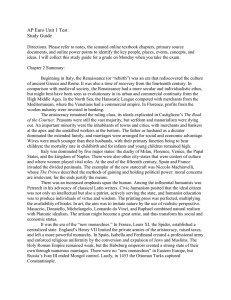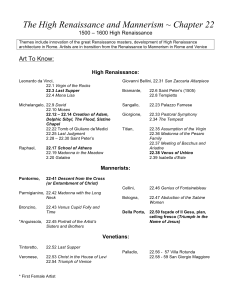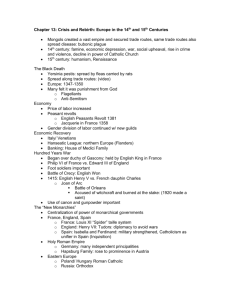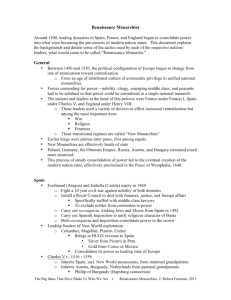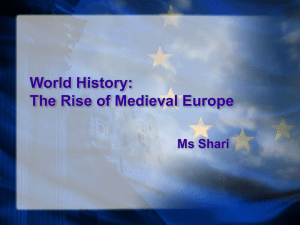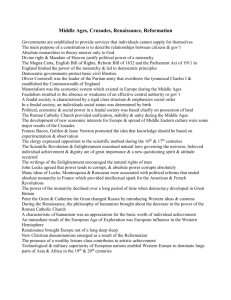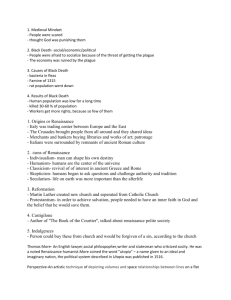The European State in the Renaissance The New Monarchies and
advertisement
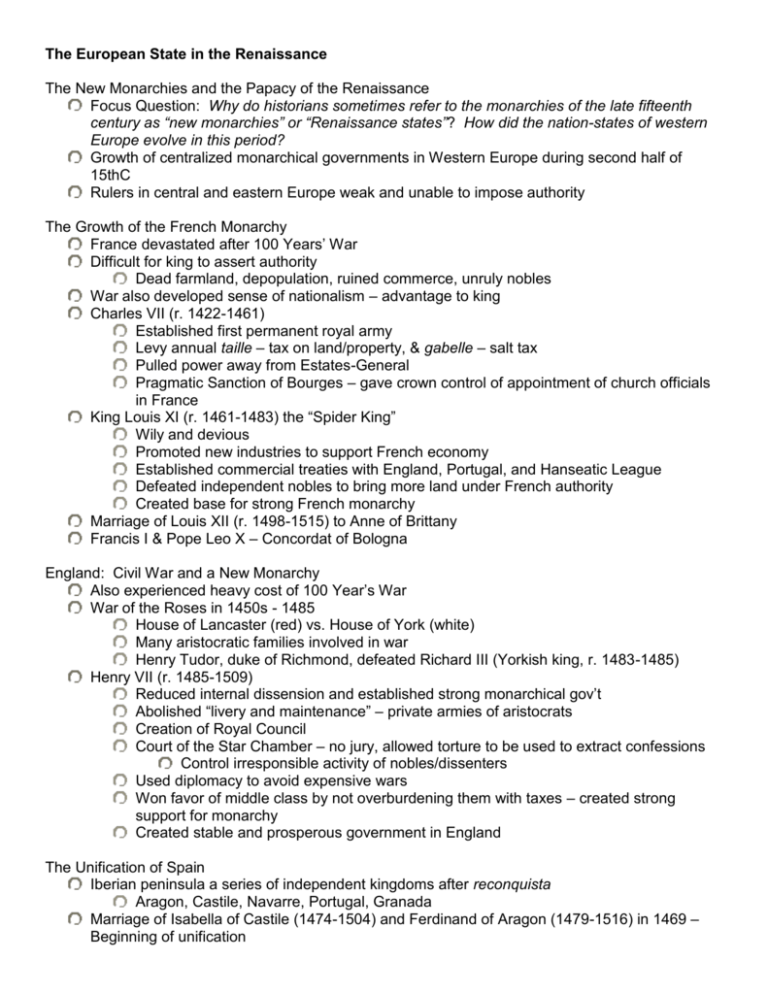
The European State in the Renaissance The New Monarchies and the Papacy of the Renaissance Focus Question: Why do historians sometimes refer to the monarchies of the late fifteenth century as “new monarchies” or “Renaissance states”? How did the nation-states of western Europe evolve in this period? Growth of centralized monarchical governments in Western Europe during second half of 15thC Rulers in central and eastern Europe weak and unable to impose authority The Growth of the French Monarchy France devastated after 100 Years’ War Difficult for king to assert authority Dead farmland, depopulation, ruined commerce, unruly nobles War also developed sense of nationalism – advantage to king Charles VII (r. 1422-1461) Established first permanent royal army Levy annual taille – tax on land/property, & gabelle – salt tax Pulled power away from Estates-General Pragmatic Sanction of Bourges – gave crown control of appointment of church officials in France King Louis XI (r. 1461-1483) the “Spider King” Wily and devious Promoted new industries to support French economy Established commercial treaties with England, Portugal, and Hanseatic League Defeated independent nobles to bring more land under French authority Created base for strong French monarchy Marriage of Louis XII (r. 1498-1515) to Anne of Brittany Francis I & Pope Leo X – Concordat of Bologna England: Civil War and a New Monarchy Also experienced heavy cost of 100 Year’s War War of the Roses in 1450s - 1485 House of Lancaster (red) vs. House of York (white) Many aristocratic families involved in war Henry Tudor, duke of Richmond, defeated Richard III (Yorkish king, r. 1483-1485) Henry VII (r. 1485-1509) Reduced internal dissension and established strong monarchical gov’t Abolished “livery and maintenance” – private armies of aristocrats Creation of Royal Council Court of the Star Chamber – no jury, allowed torture to be used to extract confessions Control irresponsible activity of nobles/dissenters Used diplomacy to avoid expensive wars Won favor of middle class by not overburdening them with taxes – created strong support for monarchy Created stable and prosperous government in England The Unification of Spain Iberian peninsula a series of independent kingdoms after reconquista Aragon, Castile, Navarre, Portugal, Granada Marriage of Isabella of Castile (1474-1504) and Ferdinand of Aragon (1479-1516) in 1469 – Beginning of unification Dynastic, not political union Both kingdoms retained separate governments, but I & F worked together to strengthen royal control of gov’t in each Reorganized military forces to create stronger royal army – best in Europe by 16thC Controlled Catholic church in Spain Promoted strict religious uniformity – create unity and bolster royal power Large groups of religious minorities – Jews and Muslims Spain had remained tolerate of them through Middle Ages Jews had lots of influence in economic and intellectual affairs 14thC – Increased persecution of Jews led to majority of Spanish Jews to convert to Christianity Complaints of Jews secretly reverting to Judaism Inquisition of 1478 Torture, persecution of conversos Conquest of Muslim Granada – 1492 Expulsion of all Muslims Expulsion of Jews – 1492 150,000 of 200,000 Jews left Spain Spain = Catholicism The Holy Roman Empire: The Success of the Habsburgs HRE failed to develop a strong monarchical authority After 1438 fell to Habsburg dynasty Wealthy landowners in Europe Success of family due to well-executed policy of dynastic marriages Maximilian I (r. 1493-1519) Attempted to centralize the administration by creating new institutions common to the entire empire Opposed by German princes – failed attempt Only real success in marriage alliances Philip of Burgundy (Max’s son) marriage Joanna, daughter of Ferdinand and Isabella Produced Charles V – inherited Habsburg, Burgundian, and Spanish territories Became leading monarch of his time The Renaissance Papacy Encompasses line of popes from end of Great Schism to beginnings of the Reformation Temporal preoccupations overcame spiritual guidance of church Julius II (r. 1503-1513) – “Warrior Pope” Pope most involved in war and politics – personally led armies against his enemies Popes relied on nepotism to promote their families’ interests Pope Sixtus IV (r. 1471-1484) made five of his nephews cardinals Pope Alexander VI (r. 1492-1503) known for debauchery and sensuality First pope to acknowledge children Encourage his son Cesare Borgia to create a state for himself in Italy Renaissance popes great patrons of Renaissance culture Julius II rebuilt St. Peter’s Basilica Leo X (r. 1513-1521) also a patron of the arts Son of Lorenzo de’ Medici Made Rome literary and artistic center of High Renaissance
